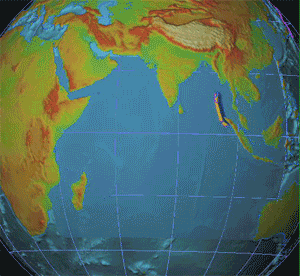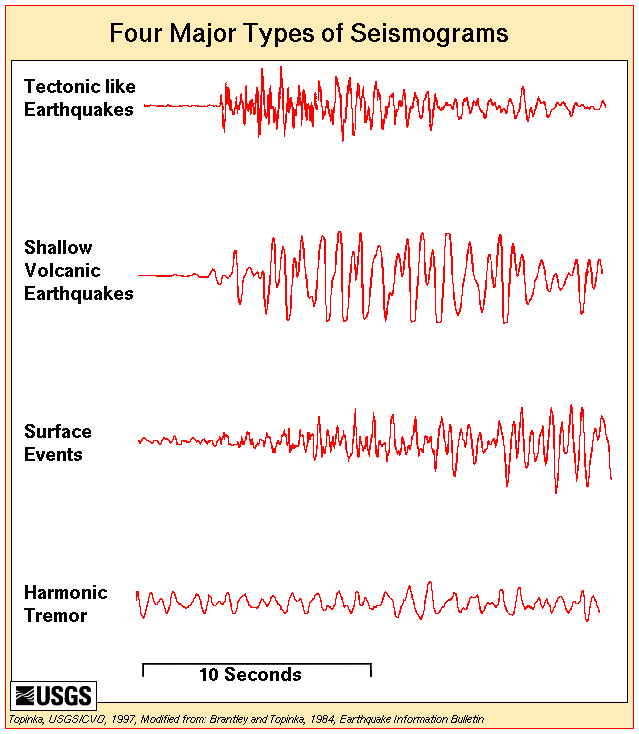|
Volcanic Tremor
A harmonic tremor is a sustained release of seismic Seismology (; from Ancient Greek σεισμός (''seismós'') meaning "earthquake" and -λογία (''-logía'') meaning "study of") is the scientific study of earthquakes (or generally, quakes) and the generation and propagation of elastic ... and infrasonic energy typically associated with the underground movement of magma, the venting of volcanic gases from magma, or both in volcanoes, and with repetitive stick-slip or other impulsive activity in non-volcanic systems. It is a long-duration release of seismic energy, often containing distinct spectral lines. Volcanic tremor often precedes or accompanies a volcanic eruption. Being a long-duration continuous signal from a temporally extended source tremor contrasts distinctly with transient and often impulsive sources of seismic radiation typically associated with earthquakes and explosions. Nonvolcanic, episodic tremor at plate boundaries (particularly in subduction zo ... [...More Info...] [...Related Items...] OR: [Wikipedia] [Google] [Baidu] |
Episodic Tremor And Slip
Episodic tremor and slip (ETS) is a seismological phenomenon observed in some subduction zones that is characterized by non-earthquake seismic rumbling, or tremor, and slow slip along the plate interface. Slow slip events are distinguished from earthquakes by their propagation speed and focus. In slow slip events, there is an apparent reversal of crustal motion, although the fault motion remains consistent with the direction of subduction. ETS events themselves are imperceptible to human beings and do not cause damage. Discovery Nonvolcanic, episodic tremor was first identified in southwest Japan in 2002. Shortly afterwards, the Geological Survey of Canada coined the term "episodic tremor and slip" to characterize observations of GPS measurements in the Vancouver Island area. Vancouver Island lies in the eastern, North American region of the Cascadia subduction zone. ETS events in Cascadia were observed to reoccur cyclically with a period of approximately 14 months. Analysi ... [...More Info...] [...Related Items...] OR: [Wikipedia] [Google] [Baidu] |
Seismology
Seismology (; from Ancient Greek σεισμός (''seismós'') meaning "earthquake" and -λογία (''-logía'') meaning "study of") is the scientific study of earthquakes (or generally, quakes) and the generation and propagation of elastic waves through planetary bodies. It also includes studies of the environmental effects of earthquakes such as tsunamis; other seismic sources such as volcanoes, plate tectonics, glaciers, rivers, oceanic microseisms, and the atmosphere; and artificial processes such as explosions. Paleoseismology is a related field that uses geology to infer information regarding past earthquakes. A recording of Earth's motion as a function of time, created by a seismograph is called a seismogram. A seismologist is a scientist who works in basic or applied seismology. History Scholarly interest in earthquakes can be traced back to antiquity. Early speculations on the natural causes of earthquakes were included in the writings of Thales of Miletu ... [...More Info...] [...Related Items...] OR: [Wikipedia] [Google] [Baidu] |
Volcano Tectonic Earthquake
A volcano tectonic earthquake or volcano earthquake is caused by the movement of magma beneath the surface of the Earth. The movement results in pressure changes where the rock around the magma has a change in stress. At some point, this stress can cause the rock to break or move. This seismic activity is used by scientists to monitor volcanoes. The earthquakes may also be related to dike intrusion and/or occur as earthquake swarms. Usually they are characterised by high seismic frequency and lack the pattern of a main shock followed by a decaying aftershock distribution of fault related tectonic earthquakes. Cause of volcano tectonic earthquakes One possible scenario resulting in a possible volcano tectonic earthquake occurs in tectonic subduction zones. The compression of plates at these subduction zones forces the magma beneath them to move. Magma can not move through the newly compressed crust as easily. This means it tends to pool in magma chambers beneath the surface and ... [...More Info...] [...Related Items...] OR: [Wikipedia] [Google] [Baidu] |
Nature (journal)
''Nature'' is a British weekly scientific journal founded and based in London, England. As a multidisciplinary publication, ''Nature'' features Peer review, peer-reviewed research from a variety of academic disciplines, mainly in science and technology. It has core editorial offices across the United States, continental Europe, and Asia under the international scientific publishing company Springer Nature. ''Nature'' was one of the world's most cited scientific journals by the Science Edition of the 2022 ''Journal Citation Reports'' (with an ascribed impact factor of 50.5), making it one of the world's most-read and most prestigious academic journals. , it claimed an online readership of about three million unique readers per month. Founded in the autumn of 1869, ''Nature'' was first circulated by Norman Lockyer and Alexander MacMillan (publisher), Alexander MacMillan as a public forum for scientific innovations. The mid-20th century facilitated an editorial expansion for the j ... [...More Info...] [...Related Items...] OR: [Wikipedia] [Google] [Baidu] |
United States Geological Survey
The United States Geological Survey (USGS), founded as the Geological Survey, is an agency of the U.S. Department of the Interior whose work spans the disciplines of biology, geography, geology, and hydrology. The agency was founded on March 3, 1879, to study the landscape of the United States, its natural resources, and the natural hazards that threaten it. The agency also makes maps of planets and moons, based on data from U.S. space probes. The sole scientific agency of the U.S. Department of the Interior, USGS is a fact-finding research organization with no regulatory responsibility. It is headquartered in Reston, Virginia, with major offices near Lakewood, Colorado; at the Denver Federal Center; and in NASA Research Park in California. In 2009, it employed about 8,670 people. The current motto of the USGS, in use since August 1997, is "science for a changing world". The agency's previous slogan, adopted on its hundredth anniversary, was "Earth Science in the Pub ... [...More Info...] [...Related Items...] OR: [Wikipedia] [Google] [Baidu] |
Volcanologist
A volcanologist, or volcano scientist, is a geologist who focuses on understanding the formation and eruptive activity of volcanoes. Volcanologists frequently visit volcanoes, sometimes active ones, to observe and monitor volcanic eruptions, collect eruptive products including tephra (such as Volcanic ash, ash or pumice), Rock (geology), rock and lava samples. One major focus of inquiry in recent times is the prediction of eruptions to alleviate the impact on surrounding populations and monitor natural hazards associated with volcanic activity. Geologists who research volcanic materials that make up the solid Earth are referred to as igneous petrologists. Etymology The word ''volcanologist'' (or ''vulcanologist'') is derived from the English volcanology (volcano + wikt:-logy, -logy), which was derived from the French wikt:volcanologie#French, volcanologie (or vulcanologie), which was further derived from the French word wikt:volcan#French, volcan (volcano), which was even furt ... [...More Info...] [...Related Items...] OR: [Wikipedia] [Google] [Baidu] |
Bernard Chouet
Bernard A. Chouet (born 14 October 1945) is a geophysicist who specializes in volcanic seismology. He discovered that volcanic eruptions could be predicted by observing the frequency of certain seismic waves that are generated by volcanoes. Background Bernard Chouet was born on 14 October 1945 in Nyon, Switzerland. In 1968 he received a diploma in electrical engineering from the Federal Institute of Technology in Lausanne, Switzerland. After graduation, he worked briefly at a Swiss robotics laboratory. Seeking an opportunity to do research in robotics, he subsequently worked at the Massachusetts Institute of Technology (MIT); specifically, at the Man-Vehicle Laboratory in the Center for Space Research, which was doing research for NASA’s Apollo program to land men on the Moon. However, when NASA’s budget was reduced, he was free to pursue other interests. As a teenager, he had become interested in volcanoes. So, after completing a master of science degree in aeronautics ... [...More Info...] [...Related Items...] OR: [Wikipedia] [Google] [Baidu] |
Slow Earthquake
A slow earthquake, also known as a silent earthquake, is a discontinuous, earthquake-like event that releases energy over a period of hours to months, rather than the seconds to minutes characteristic of a typical earthquake. First detected using long term strain measurements, most slow earthquakes now appear to be accompanied by fluid flow and related tremor, which can be detected and approximately located using seismometer data filtered appropriately (typically in the 1–5 Hz band). That is, they are quiet compared to a regular earthquake, but not "silent" as described in the past. Slow earthquakes should not be confused with tsunami earthquakes, in which relatively slow rupture velocity produces tsunami out of proportion to the triggering earthquake. In a tsunami earthquake, the rupture propagates along the fault more slowly than usual, but the energy release occurs on a similar timescale to other earthquakes. __TOC__ Causes Earthquakes occur as a consequence of gradu ... [...More Info...] [...Related Items...] OR: [Wikipedia] [Google] [Baidu] |
Explosion
An explosion is a rapid expansion in volume of a given amount of matter associated with an extreme outward release of energy, usually with the generation of high temperatures and release of high-pressure gases. Explosions may also be generated by a slower expansion that would normally not be forceful, but is not allowed to expand, so that when whatever is containing the expansion is broken by the pressure that builds as the matter inside tries to expand, the matter expands forcefully. An example of this is a Volcano, volcanic eruption created by the expansion of magma in a magma chamber as it rises to the surface. Supersonic explosions created by high explosives are known as detonations and travel through shock waves. wikt:subsonic, Subsonic explosions are created by low explosives through a slower combustion process known as deflagration. Causes For an explosion to occur, there must be a rapid, forceful expansion of matter. There are numerous ways this can happen, both natura ... [...More Info...] [...Related Items...] OR: [Wikipedia] [Google] [Baidu] |
Earthquake
An earthquakealso called a quake, tremor, or tembloris the shaking of the Earth's surface resulting from a sudden release of energy in the lithosphere that creates seismic waves. Earthquakes can range in intensity, from those so weak they cannot be felt, to those violent enough to propel objects and people into the air, damage critical infrastructure, and wreak destruction across entire cities. The seismic activity of an area is the frequency, type, and size of earthquakes experienced over a particular time. The seismicity at a particular location in the Earth is the average rate of seismic energy release per unit volume. In its most general sense, the word ''earthquake'' is used to describe any seismic event that generates seismic waves. Earthquakes can occur naturally or be induced by human activities, such as mining, fracking, and nuclear weapons testing. The initial point of rupture is called the hypocenter or focus, while the ground level directly above it is the ... [...More Info...] [...Related Items...] OR: [Wikipedia] [Google] [Baidu] |







